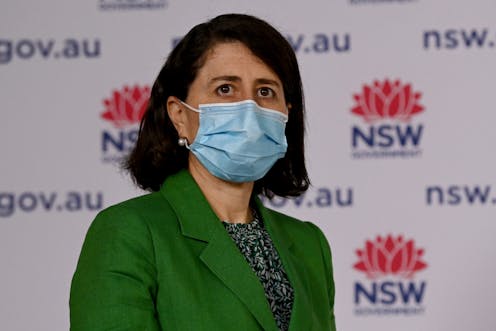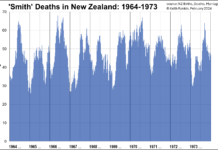Source: The Conversation (Au and NZ) – By Adrian Beaumont, Honorary Associate, School of Mathematics and Statistics, The University of Melbourne

AAP/Bianca de Marchi
A New South Wales state Resolve poll for The Sydney Morning Herald gave the Coalition 41% of the primary vote (down two since July), Labor 30% (up two), the Greens 11% (down one), the Shooters 2% (up one) and independents 10% (steady).
Resolve does not provide two party estimates, but analyst Kevin Bonham estimated 53-47 to the Coalition, a two-point gain for Labor since July. I previously covered issues with the independent vote in Resolve and the lack of two party estimates.
Read more:
Coalition gains in federal Resolve poll, but Labor increases lead in Victoria
Incumbent Liberal Gladys Berejiklian led Labor’s Chris Minns by 48-21 as preferred premier (55-16 in July). This poll would have been conducted concurrently with the August and September federal polls from a sample of about 1,100. The federal Resolve polls in those months have had a strong lean to the Coalition compared with other polls (see below).
By 65-17, voters supported “the plan to ease restrictions in mid-October with 70% vaccination rates”. The SMH article implies the Coalition’s position was stronger in September than August, as vaccination uptake makes reopening soon realistic.
The same situation applies to the federal government. Once lockdowns are over, the economy is likely to rebound quickly, and this will assist the Coalition in an election in the first half of next year.
Newspoll: Andrews has best approval out of Vic, Qld and NSW premiers
The Poll Bludger reported that Newspoll asked for premiers’ ratings in last weekend’s poll from a larger than usual national sample of 2,144.
The states considered were NSW, Victoria and Queensland. Victorian Labor premier Daniel Andrews had a 64-35 satisfied rating (net +29). Queensland Labor premier Annastacia Palaszczuk had a 57-38 satisfied rating (net +19). Berejiklian had a 56-40 satisfied rating (net +16).
On handling COVID, Palaszczuk scored far better than her overall rating at 67-31 good, while Andrews and Berejiklian scored nearly the same (63-35 good for Andrews, 56-41 good for Berejiklian).
Nationally, Scott Morrison had a -4 net approval in Newspoll; he was at +15 in Queensland, -3 in NSW and -16 in Victoria.
Nationally, Morrison had a 49-48 poor rating for his handling of COVID, unchanged from six weeks ago. By 53-42, voters expressed more concern with relaxing restrictions too fast than too slowly (62-34 in January).
WA upper house electoral reform: group ticket voting and malapportionment to be scrapped
The massive WA Labor landslide at the March state election gave them large majorities in both chambers of the WA parliament – the first ever Labor majority in the upper house.
Read more:
Coalition and Morrison gain in Newspoll, and the new Resolve poll
Labor set up a committee to look at reforming the upper house’s electoral system. There are two current major problems: malapportionment and group ticket voting (GTV). The Mining & Pastoral region and Agricultural region elect one-third of the upper house on just 10% of the state’s population. GTV allowed Daylight Saving to win a seat in March on just 98 primary votes.
Labor will adopt the committee’s proposals to change to a statewide election of 37 members, up from the current 36. GTV will be replaced by optional above-the-line voting, in which a single “1” above the line will stay within the party it is cast for. Voters can number “2”, “3”, etc, above the line to continue directing preferences after their original party is excluded.
This system is the same as is currently used in elections for the NSW and SA upper houses. However, these states elect half their upper house at each election (21 seats up each election in NSW and 11 in SA). The WA proposal is for all 37 seats to be elected at once, so the quota will be just 2.63%.
With optional preferential voting, parties will be able to win seats from much lower vote shares than 2.63%. It’s likely to lead to cluttered ballot papers at the next election.
ABC election analyst Antony Green has much more on the WA reforms. I hope the Victorian government scraps GTV before the 2022 state election – Victoria is now the last Australian jurisdiction with GTV.
Other state developments: NT, Victoria and Tasmania
The Labor Northern Territory government gained Daly at a September 11 byelection by a 56.0-44.0 margin over the CLP, a 7.2% swing to Labor. Bonham said this is the first time a government gained from an opposition at a byelection anywhere in Australia since Benalla (Victoria state) in 2000.
Matthew Guy ousted Michael O’Brien as Victorian Liberal leader at a leadership spill on September 7. Guy led the Liberals to a landslide defeat at the November 2018 state election.
A Tasmanian EMRS poll, conducted August 7-9 from a sample of 1,000, gave the Liberals 49% (steady since the May election), Labor 28% (steady) and the Greens 13% (up one). Incumbent Peter Gutwein led Labor’s Rebecca White as preferred premier by 59-29 (61-26 in EMRS’ last state poll in February).
Coalition leads on estimated preference flows in federal Resolve poll
A federal Resolve poll for Nine newapapers, conducted September 15-19 from a sample of 1,606, gave the Coalition 39% of the primary vote (down one since August), Labor 31% (down one), the Greens 10% (down two), One Nation 4% (up two), Clive Palmer’s United Australia Party 3% and independents 9% (down one).
No two-party estimate was given, but Bonham estimated 51-49 to the Coalition, a one-point gain for the Coalition.
There’s divergence in voting intentions between Resolve and Newspoll, which was 53-47 to Labor. But there’s been movement in all recent polls to the Coalition, which was up one in Newspoll and up two in Morgan to a 52.5-47.5 Labor lead.
49% gave Morrison a good rating for his performance in recent weeks, and 45% a poor rating, for a net +4 rating, up five since August. Albanese’s net approval was up three to -16. Morrison led as preferred PM by 45-26 (46-23 in August).
The Liberals and Morrison led Labor and Albanese by 42-24 on economic management (44-19 in August). On COVID, the Liberals led by 37-24 (37-22 last time).
Canadian election called two years early gives nearly status quo result
I live blogged the results of the Canadian election that PM Justin Trudeau called two years early for The Poll Bludger. At the 2019 election, Trudeau’s centre-left Liberals won 157 of the 338 seats and the Conservatives 121, despite a 1.2% lead for the Conservatives in vote shares. In 2021, the results are nearly the same.
The German election will be held Sunday, with polls closing at 2am Monday AEST. Parties need to either win at least 5% nationally or three of the 299 single-member seats to qualify for a proportional seat allocation. The Guardian’s poll aggregate
suggests the overall left parties have a narrow lead over the overall right. I will be live blogging for The Poll Bludger.
![]()
Adrian Beaumont does not work for, consult, own shares in or receive funding from any company or organisation that would benefit from this article, and has disclosed no relevant affiliations beyond their academic appointment.
– ref. Coalition still well ahead in NSW poll, Newspoll premiers’ ratings, and WA upper house electoral reforms – https://theconversation.com/coalition-still-well-ahead-in-nsw-poll-newspoll-premiers-ratings-and-wa-upper-house-electoral-reforms-168259








